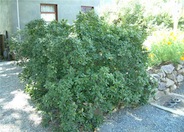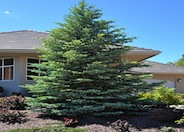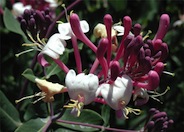
Common name:Mondo Grass, Black
Botanical name:Ophiopogon planiscapus 'Nigrescens'
This plant makes a tuft of approximately 8" and is about 1' wide. It has very unusual leaves that start out green and turn black in a couple of weeks. It has pink summer flowers but is grown for the unusual black foliage.

Common name:Coffeeberry, California
Botanical name:Rhamnus californica
The California Coffeeberry is an evergreen shrub that reaches 6'-8' high. It has red berries that turn black in late summer, which attracts birds. This shrub tolerates sun or partial shade in all soil types. This CA native is drought tolerant once it's established. It is a beneficial insect plant and attracts butterflies. In ocean areas, this plant looks more like a ground cover. Small flowers appear in spring but are considered insignificant.

Common name:Colorado Spruce
Botanical name:Picea pungens
The Picea pungens is a tall evergreen tree that grows to 100' tall. It is broadly pyramidal in form, with foliage varying in shades of blues and greens. This is a highly combustible plant. This plant is fire-prone! Please use caution when planting near your home.

Common name:Japanese Honeysuckle, Hall's
Botanical name:Lonicera X americana 'Pam's Pink'
This semi-evergreen vine is twining with bluish green foliage and beautiful pink and white, trumpet-shaped flowers. This variety is not as agressive as other species in regards to growth; it seems to have less problem with powdery mildew. Flowers bloom in early to mid spring. Flowers are faintly fragrant. This variety of Lonicera can reach 4'-5' in height and 6' long. Its growth rate is moderate to fast. Leaves are waxy. This is a beautiful vine for a trellis.

Common name:Japanese Maple
Botanical name:Acer palmatum
This magnificient plant can used as a small tree or shrub. It is deciduous with graceful leaves which have a scarlet color in spring as it leafs out. Leaves later turn orange or yellow in fall. It is slow growing to 20', and requires shelter from the hot sun. The leaves of this tree are small, light green in color, and deeply lobed. It should also be noted that this tree remains spectacular throughout all seasons. (2nd photo courtesy of Steve Mullany)
If you mulch heavily as recommended in the compost and mulch fact sheets you should not need traditional fertilization. Sustainable landscapes fertilize themselves as soil organisms break down and recycle the dropped leaves into nutrients.
Click in the green box for more information
Designer: Solid Ground Landscape/G.Covey
Photographer: GardenSoft
Practice grass-cycling by leaving short grass clippings on lawns after mowing, so that nutrients and organic matter are returned to the soil.
Mulching and adding compost to soil can minimize evaporation and help soil absorb and store water.
Attract, or buy beneficial insects such as ladybugs and lacewings to control pest outbreaks in your garden.